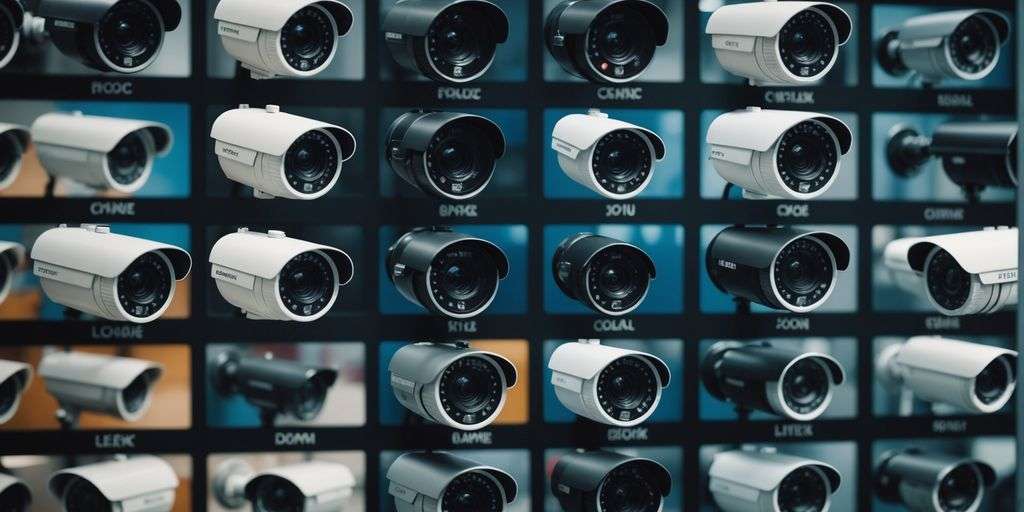Understanding Indoor and Outdoor CCTV Cameras
Indoor Camera Features
Indoor cameras are designed to monitor the inside of buildings. They are typically smaller and more discreet than outdoor cameras. These cameras are perfect for keeping an eye on your home’s interior while you are away. They can also be used to watch over children or pets. Many indoor cameras come with features like motion detection, two-way audio, and high-definition video quality.
Outdoor Camera Durability
Outdoor cameras are built to withstand harsh weather conditions and potential tampering. They are usually more robust and durable compared to indoor cameras. These cameras often come with features such as weatherproof casings, night vision, and wide-angle lenses. Outdoor cameras are essential for monitoring the exterior of your property, providing an extra layer of security.
Common Uses for Indoor and Outdoor Cameras
Both indoor and outdoor cameras serve various purposes. Indoor cameras are commonly used for monitoring living spaces, offices, and other indoor areas. Outdoor cameras are ideal for observing entrances, driveways, and gardens. They are also useful for traffic monitoring and overseeing hazardous areas. By strategically placing these cameras, you can ensure comprehensive security coverage for your property.
For a successful CCTV installation, it is crucial to choose the right type of camera for each location. This ensures that the system is fully operational and provides the best possible security coverage.
Exploring Specialised CCTV Cameras
Infrared Cameras for Night Vision
Infrared cameras are designed to capture clear images in low-light or no-light conditions. They use infrared LEDs to illuminate the area, making them ideal for night-time surveillance. These cameras are essential for 24/7 security monitoring. They are commonly used in parking lots, warehouses, and other areas that need constant surveillance.
Pan-Tilt-Zoom Cameras for Flexibility
Pan-Tilt-Zoom (PTZ) cameras offer the ability to move left, right, up, and down, and zoom in on specific areas. This flexibility allows for comprehensive coverage of large spaces. PTZ cameras are often used in shopping centres, stadiums, and other large venues where monitoring multiple areas is crucial.
Hidden Cameras for Discreet Surveillance
Hidden cameras are designed to blend into their surroundings, making them difficult to detect. They are often used for discreet monitoring in places like offices, retail stores, and homes. These cameras are perfect for situations where covert surveillance is necessary. Hidden cameras can be embedded in everyday objects like clocks, smoke detectors, and even picture frames.
Specialised CCTV cameras offer unique features that cater to specific surveillance needs, ensuring comprehensive security coverage in various environments.
Choosing the Right CCTV Camera for Your Needs

Assessing Your Security Requirements
When selecting a CCTV camera, it’s crucial to first understand your specific security needs. Are you looking to monitor a large outdoor area or a small indoor space? Identifying the primary purpose of the surveillance will help narrow down your options. Consider factors like lighting conditions, the size of the area, and the level of detail you need in the footage.
Comparing Wired and Wireless Systems
Wired CCTV systems are known for their reliability and consistent video quality. They are ideal for permanent installations where running cables is not an issue. On the other hand, wireless systems offer flexibility and ease of installation, making them suitable for temporary setups or locations where cabling is impractical. Weighing the pros and cons of each system type will guide you in making an informed decision.
Installation Tips and Best Practises
Proper installation is key to maximising the effectiveness of your CCTV system. Ensure cameras are placed at strategic points to cover all vulnerable areas. Avoid placing cameras where they can be easily tampered with. Regular maintenance, such as cleaning the lenses and checking the connections, will ensure your system remains operational. Following these best practises will help you get the most out of your CCTV investment.
Remember, the right CCTV camera can significantly enhance your security, but only if chosen and installed correctly. Take the time to assess your needs and explore your options thoroughly.
Conclusion
In wrapping up our guide on CCTV camera types, it’s clear that these devices play a crucial role in keeping our spaces safe. From indoor to outdoor, and from dome to bullet cameras, each type has its own special features and uses. Whether you’re looking to monitor traffic, secure a building, or keep an eye on a hazardous area, there’s a CCTV camera suited for the job. By understanding the different options available, you can make a smart choice that meets your security needs. Remember, the right camera can make all the difference in creating a safer environment for everyone.
Frequently Asked Questions
What is the difference between indoor and outdoor CCTV cameras?
Indoor CCTV cameras are designed for use inside buildings and usually focus on monitoring specific rooms or areas. Outdoor CCTV cameras, on the other hand, are built to withstand weather conditions and are often used to monitor the exterior of buildings or open spaces.
How do infrared cameras work at night?
Infrared cameras use infrared light to see in the dark. They have special sensors that can detect infrared light, which is invisible to the human eye, and convert it into an image that we can see.
What are the benefits of using a pan-tilt-zoom (PTZ) camera?
PTZ cameras can move up, down, and side to side, and they can zoom in and out. This makes them very flexible and useful for monitoring large areas with a single camera.





